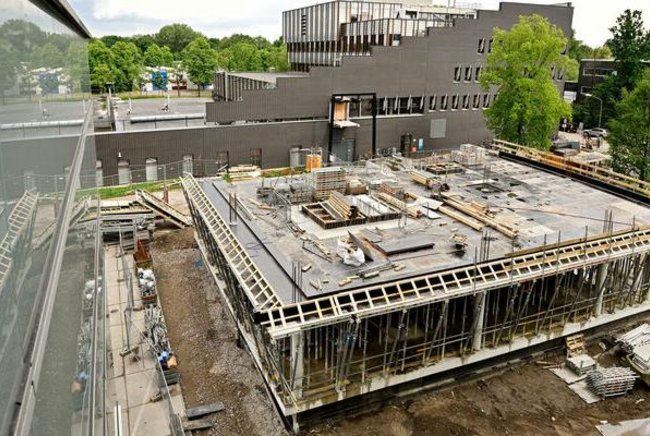Qubit: more than meets the eye
While it may appear to passers-by that construction work on the quantum building between Flux and Cascade has only just begun, the extensive underground lab space below ground level has already taken shape. The new building, which will be named Qubit, won’t just accommodate the Coherence and Quantum Technology (CQT) research group at the end of this year, but it will also function as a hub for everyone in Eindhoven who works on quantum technology.

Qubit will accommodate TU/e’s first underground laboratories, future inhabitant Servaas Kokkelmans says enthusiastically. Kokkelmans is a quantum physicist in the CQT group and scientific director of the Center for Quantum Materials and Technology Eindhoven (QT/e, the quantum branch of the Eindhoven Hendrik Casimir Institute). In the latter capacity, he was closely involved with the realization of the new building. “Qubit will be much larger below ground level than it seems from the outside, no less than 640 square meters.” This construction has been made possible in part thanks to a financial contribution from Quantum Delta NL, a partnership between quantum research centers in the Netherlands, which was awarded over 600 million euros from the National Growth Fund last year.
“Quantum Delta NL pays a quarter of the costs,” Kokkelmans says. “We weren’t allowed to build more than three floors above ground, but there was more space available below ground level.” As it turned out, that took quite some effort technically speaking, he explains. “The soil on campus is quite soggy.” That’s also the reason, Kokkelmans says, why the current TU/e terrain, which is only at a walking distance from the city center, was still available as a construction site when the Eindhoven University of Technology was founded. “Until that time, it was practically impossible to build here due to the damp soil. This is also why they placed a dam wall around the construction pit, fortified with a construction made of metal pipes, to drain the surface when construction activities for Qubit commenced. Naturally, we didn’t want Flux to subside as a result of construction activities.”
The part of the building above the ground, which will be connected to Flux via a footbridge, won’t just have office spaces, but a reception area as well. “That area will be furnished in the atmosphere of Quantum Delta NL. This is where we will receive guests from other universities and from companies, and where we will introduce students and school children to quantum technology.”
X-rays
In the meantime, the actual work will take place below ground, safely shielded from the building’s surroundings. “We need a very stable environment for our experiments with ultracold atoms and ions, without too many vibrations and fluctuations in temperature and humidity,” Kokkelmans explains. “That is why the floor is extra thick, for example.” Researchers at CQT also work with setups for X-ray generation. “Particularly in the Smartlight project from my colleagues Jom Luiten and Peter Mutsaers. Naturally, it’s important that radiation doesn’t leak into the environment; that’s another reason why an underground lab is very practical.”
The basement of Qubit is also where Kokkelmans and his colleagues will be working on Eindhoven’s quantum computer. “It will be a hybrid type, based on ultracold rubidium and strontium atoms trapped in a lattice of light, which we can position in space individually using so-called optical tweezers. My colleagues Edgar Vredenbregt, Rianne Lous – who joined us on June 1, after she came over from UvA – and I are working on this within a Quantum Delta NL project. The intention is to make that quantum computer part of a national infrastructure for quantum computers in 2024, known as Quantum Inspire, in first instance with nine qubits.”
Focus point
It was announced this week, incidentally, that French scientist Philippe Bouyer has been appointed coordinator of one of Quantum Delta NL’s three so-called Catalyst programs. In this capacity, Bouyer will also be affiliated with TU/e.
Qubit won’t just accommodate the physicists of the CQT group, but guests and representatives from other departments as well, Kokkelmans emphasizes. “They won’t have any lab facilities, but room has been made available for office spaces for colleagues from Electrical Engineering, who are also involved with Quantum Delta NL. The offices of the Eindhoven Hendrik Casimir Institute, under supervision of managing director Wieteke de Boer, will also be located in Qubit. The building will become a true focus point of quantum technology in Eindhoven.”
Source: TOM JELTES, Cursor Foto: BART VAN OVERBEEKE